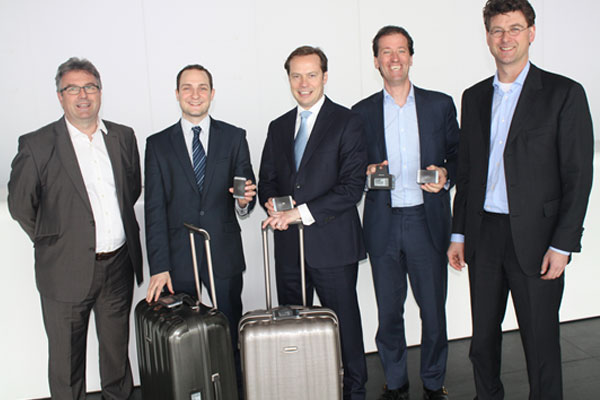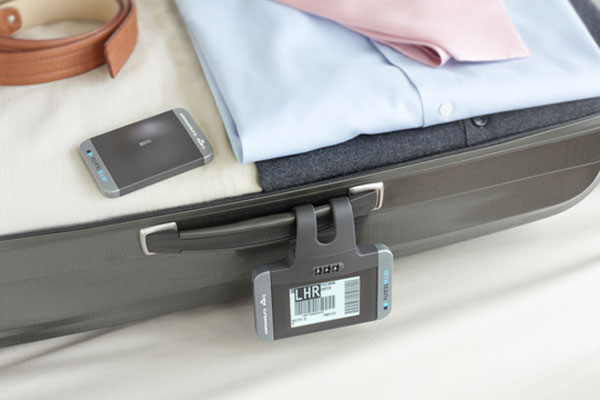Over the last 12 months, interest in permanent bag tags has increased apace as the viability of the concept has been proved, and Air France-KLM has this week launched the latest innovation in this field. The permanent bag tag, called eTag, and the eTrack tracking device have been developed by the airline alongside FastTrack Company, Samsonite and KPN with significant input also coming from Delta Air Lines.
The eTag is an electronic baggage label that includes two e-ink displays and that attaches to the outside of the suitcase, while eTrack is placed inside the luggage. In addition, a limited edition suitcase – the Samsonite Track & Trace, which includes embedded eTag and eTrack devices – has been revealed.
Speaking to FTE, Manuel van Lijf, Manager Product Innovation, Air France-KLM, explained: “We’ve worked closely with our suppliers and with Delta to try to make this an industry initiative, not just an airline initiative, and we’ve had involvement from SkyTeam too and kept them updated throughout the process.
“We thought it would be useless to just develop something for us – we wanted to develop something that will benefit the industry and the passengers. The idea was to create a product that can be used by a passenger flying with Air France, KLM, Delta, Lufthansa or another airline, for instance. Why would a passenger buy a permanent tag that can only be used on one airline?”
Making use of Bluetooth, GSM and GPS technology

eTrack makes use of GSM, GPS and Bluetooth technology, which enables it to be tracked by a smartphone, while eTag also utilises Bluetooth. Passengers with a Flying Blue account can link the eTag and eTrack devices to their account, so when they check-in online, the permanent bag tag will be automatically updated within just five seconds. The tag communicates with the outside world via the eTrack device, and directly with smartphones using Bluetooth, but the two products can also be used independently.
“Bluetooth technology is used worldwide, so it makes sense for us to use it,” van Lijf stated. “With things like NFC (Near Field Communication), you would need to use more antennas, which would mean the tag would have to be bigger. We could add NFC later, but Bluetooth works fine.”
eTag and eTrack trials to start in December

While Air France-KLM and its partners initially set out to develop just a permanent bag tag, the tracking device was added in response to demand from travellers. “The passengers really wanted the tracker,” van Lijf continued. “Track and trace was a number one demand among passengers.” Having held focus groups with travellers, it was clear that the size of the permanent bag tag was also important, and while the prototype FTE previewed was relatively compact, the final product will be even smaller.
Final tweaks are still being made to eTag, eTrack and the Samsonite suitcase, but Air France-KLM is planning to start live trials before the end of the year. The plan is for a small, select group of travellers to start trialling the products in December, before they are gradually made available on a larger scale.
In terms of an initial rollout, it is likely that the tag will be offered to high value, frequent travellers, but in the longer term the bulk of eTag and eTrack devices will probably be used by customers who have actively purchased them. Considering Air France recently launched home-printed bag tags, van Lijf said the permanent tag could appeal to lots of frequent flyers, while the home-printed tags could be more popular among those who fly less frequently.
Although we may have to wait nine months to see the eTag and eTrack, as well as the Samsonite Track & Trace, in action, FTE is excited to see how they perform in a live environment. We are equally pleased with the way Air France-KLM, Delta Air Lines, FastTrack Company, Samsonite and the other companies involved in its development have sought to create a solution that will benefit all airlines and all passengers, not just a select few. It may have been evident for some time now that permanent bag tags will revolutionise the baggage process, but this latest development makes it very clear that this revolution is not very far away at all.
We are delighted to announce that Manuel Van Lijf, Manager Product Innovation, Air France-KLM, will deliver a presentation entitled ‘Experiences and lessons learned from launching home-printed and permanent bag tags’ as part of the Baggage Advancements Workshop at FTE Global 2014, which will take place in Las Vegas from 24-26 September.






